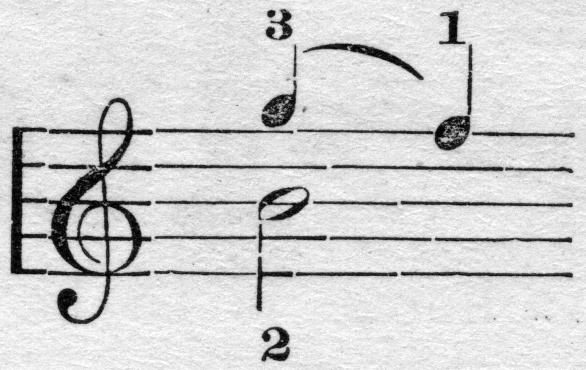In this study, and in all compositions of a similar character and tempo, the pupil will always find it advisable to count the eighths instead of the quarters. It should never be imagined that such a course is a confession of a weak sense of rhythm. It is true that this method of attaining accuracy increases appreciation of rhythm; but it does not necessarily mean that the player is unable to dispense with such aid. Indeed, the most experienced players of chamber-music find it advisable, time and again, to resort to division and subdivision of the beat in slow movements.
The progression of sixths, in the opening measure, presents a technical difficulty which demands the closest attention. The pupil readily discovers that in such a progression it is exceedingly difficult, if not impossible, to employ the fingers in the usual manner. The result, were he to do so, would demonstrate its inadvisability. The fingers should be placed upon the strings in such a manner as to admit of shifting their position, rather than raising them, for each progression. This facilitates technical accuracy, and insures the desired legato. The third beat of the 2d measure may be fingered in the ordinary way, or it may be played, as follows, in the half position:

Most pupils experience difficulty with the 4th beat of the 3d measure. The difficulty is not caused by the double-stop itself, but by the note that precedes it. In playing this last grace-note the second finger should fall on the D as well as the A string. When this is done the difficulty is immediately removed. Technical difficulties of a similar nature are of frequent occurrence, but they cease to be troublesome the very moment the player discovers the cause.
The stretch of a tenth, at the beginning of the 9th measure, is often beyond the physical possibilities of a player for no other reason than that he does not attempt it in the right way. That is, he places his first finger on the D string, and then makes a futile effort to extend the fourth finger to the note G. He should do just the reverse, especially if his fingers are either unusually short or only of ordinary length. The difficulty of such a stretch is greatly simplified by securing the position of the fourth finger before the first finger touches the string.
Most pupils are tempted to use short strokes in the 20th measure. It is never advisable to do so in a similarly constructed measure when the tempo is a slow one. The full length of the bow should be employed.
This study calls for no further comment, inasmuch as the suggestions applicable to it have been made repeatedly in connection with other studies.
The Twenty-first Caprice.
The greater part of this Caprice, it seems needless to say, is played at the upper part of the bow. That it is exceedingly difficult, when played in a rapid tempo, the pupil will not be slow to appreciate. But he should be slow, indeed, in attempting to play it rapidly. A deliberate tempo will result in much technical good, but all early efforts to reach the tempo originally intended for it would prove disastrous.
The trill in the 2d measure is played without grace- notes. The accents in which this study abounds are of such musical and technical importance that the player must make a special effort to make them stand out sharply. Beginning with the 45th measure (after the double bar), the whole bow may be utilized, but economy will be necessary in the 48th measure, as the subsequent figures demand a return to the point of the bow. The trills occurring in the 75th and 4 following measures require no terminal grace-notes. This applies, in fact, to all the shorter trills.
That this study requires a supple wrist is easily understood. But the player will often find it difficult to combine suppleness with strength. Under no circumstances, however, should he be tempted to execute with the forearm what is essentially a wrist-stroke. If this injunction is ignored, more harm than good is likely to result from the study of this Caprice.
(To be continued.)



